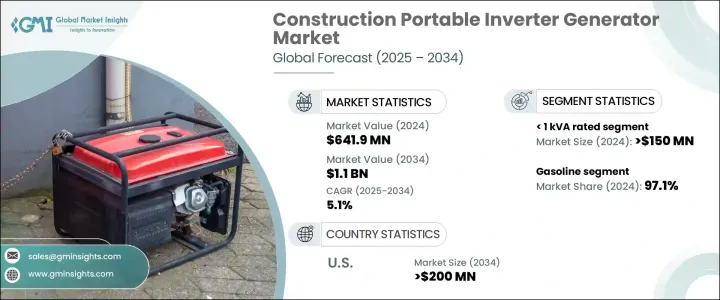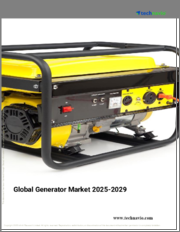
|
시장보고서
상품코드
1699324
건설용 휴대용 인버터 발전기 시장 기회, 성장 촉진요인, 산업 동향 분석, 예측(2025-2034년)Construction Portable Inverter Generator Market Opportunity, Growth Drivers, Industry Trend Analysis, and Forecast 2025-2034 |
||||||
세계의 건설용 휴대용 인버터 발전기 시장은 2024년에 6억 4,190만 달러에 달하며, 건설 현장에서 효율적이고 신뢰성 높은 전원 솔루션에 대한 수요 증가를 배경으로 2025-2034년에 CAGR 5.1%로 성장할 것으로 예측됩니다.
건설 활동의 급격한 증가와 휴대용 및 다용도 전원에 대한 요구가 결합되어 시장 확대에 박차를 가하고 있습니다. 산업 및 주거 부문이 전력 공급의 이동성과 유연성 향상을 추구함에 따라 인버터 발전기의 채택은 계속 가속화되고 있습니다.

이 발전기는 연료 효율 향상, 배기가스 배출 감소, 조용한 작동 등 여러 가지 장점이 있습니다. 소형 및 경량 설계로 인해 건설 용도에 매우 적합하며, 운송 및 배치가 용이합니다. 도시화와 인프라 개발의 빠른 속도는 현장에서 무정전 전력 공급에 대한 수요 증가에 더욱 기여하고 있습니다. 정부와 민간 개발업체들은 대규모 인프라 프로젝트에 많은 투자를 하고 있으며, 휴대용 인버터 발전기의 필요성이 증가하고 있습니다. 또한 에너지 효율이 높은 기술 및 배출 규제 조치의 발전은 전 세계에서 이러한 발전기의 채택을 촉진하고 있습니다. 탄소 배출에 대한 규제가 강화됨에 따라 제조업체들은 환경 기준에 부합하는 저탄소 및 에너지 효율이 높은 모델 생산에 주력하고 있습니다.
| 시장 범위 | |
|---|---|
| 시작연도 | 2024년 |
| 예측연도 | 2025-2034년 |
| 시작 금액 | 6억 4,190만 달러 |
| 예상 금액 | 11억 달러 |
| CAGR | 5.1% |
전력 등급별로 세분화하면 시장은 1 kVA, 1 kVA-2 kVA, 2 kVA-3 kVA, 3 kVA-4 kVA, 4 kVA 이상의 카테고리로 구성됩니다. 특히 주택 개조, 소규모 건설 공사, 인테리어 마감 공사 등 소형 및 에너지 효율이 높은 솔루션에 대한 수요는 계속 증가하고 있으며, 1kVA 부문에서만 2024년 1억 5,000만 달러의 매출을 기록할 것으로 예상되며, 소음이 적고 안정적인 전력을 제공하는 발전기에 대한 선호도가 높아지고 있습니다. 선호도가 높아지고 있습니다. 이 발전기는 소형 사이즈와 높은 연료 효율로 인해 소규모 용도에 실용적인 선택이 될 수 있습니다.
전원별로는 가솔린, 디젤, 기타 선택이 있습니다. 가솔린 구동 휴대용 인버터 발전기는 2024년 97.1% 시장 점유율로 업계를 지배하고 있습니다. 중소규모 건설 프로젝트에서 널리 채택되어 휴대가 간편하고 여러 공구에 전력을 공급할 수 있다는 장점이 결합되어 큰 수요를 주도하고 있습니다. 개발도상국에서는 비용 효율성과 에너지 효율성으로 인해 도입이 증가하고 있습니다. 연료 소비 및 배기가스 규제에 대한 기술 혁신이 진행됨에 따라 제조업체들은 진화하는 업계의 요구에 부응하기 위해 가솔린 엔진 모델의 성능 향상에 주력하고 있습니다.
미국의 건설용 휴대용 인버터 발전기 시장은 2024년에 1억 760만 달러로 평가되며 2034년에는 2억 달러에 달할 것으로 예상됩니다. 기술 발전, 규제 대응, 신뢰할 수 있는 전력 솔루션에 대한 수요 증가 등의 요인이 시장 성장을 가속화하고 있습니다. 또한 허리케인이나 산불과 같은 자연재해의 빈도가 증가함에 따라 비상시 중단 없는 전력 공급을 보장하는 발전기에 대한 수요가 증가하고 있습니다. 시장이 계속 진화함에 따라 주요 기업은 에너지 효율적이고 비용 효율적인 휴대용 전원 솔루션에 대한 수요 증가에 대응하기 위해 제품 혁신을 우선순위에 두고 있습니다.
목차
제1장 조사 방법과 조사 범위
- 시장 범위와 정의
- 시장 추산·예측 파라미터
- 예측 계산
- 데이터 소스
- 1차
- 2차
- 유료
- 공적
제2장 개요
제3장 업계 인사이트
- 업계 에코시스템 분석
- 규제 상황
- 업계에 대한 영향요인
- 성장 촉진요인
- 업계의 잠재적 리스크·과제
- 성장 가능성 분석
- Porter의 산업 분석
- PESTEL 분석
제4장 경쟁 구도
- 서론
- 전략적 전망
- 혁신과 지속가능성 전망
제5장 시장 규모·예측 : 정격 출력별, 2021-2034년
- 주요 동향
- 1kVA 이상
- 1kVA-2 kVA
- 2kVA-3 kVA
- 3kVA-4 kVA
- 4kVA 이하
제6장 시장 규모·예측 : 전원별, 2021-2034년
- 주요 동향
- 가솔린
- 디젤
- 기타
제7장 시장 규모·예측 : 지역별, 2021-2034년
- 주요 동향
- 북미
- 미국
- 캐나다
- 유럽
- 러시아
- 영국
- 독일
- 프랑스
- 스페인
- 오스트리아
- 이탈리아
- 아시아태평양
- 중국
- 호주
- 인도
- 일본
- 한국
- 인도네시아
- 말레이시아
- 태국
- 베트남
- 필리핀
- 싱가포르
- 중동
- 사우디아라비아
- 아랍에미리트
- 카타르
- 튀르키예
- 이란
- 오만
- 아프리카
- 이집트
- 나이지리아
- 알제리
- 남아프리카공화국
- 모잠비크
- 라틴아메리카
- 브라질
- 멕시코
- 아르헨티나
- 칠레
제8장 기업 개요
- A-iPower
- Atlas Copco
- Briggs &Stratton
- Caterpillar
- Champion Power Equipment
- Cummins
- Deere &Company
- DuroMax Power Equipment
- Generac Power Systems
- Ha-Ko Industries
- HIMOINSA
- Honda Motor
- Kirloskar
- Kohler
- Wacker Neuson SE
- WEN Products
- Westinghouse Electric Corporation
- Yamaha Motor
The Global Construction Portable Inverter Generator Market reached USD 641.9 million in 2024 and is projected to grow at a CAGR of 5.1% between 2025 and 2034., driven by increasing demand for efficient and reliable power solutions across construction sites. The surge in construction activities, coupled with the need for portable and versatile power sources, is fueling market expansion. As industries and residential sectors seek enhanced mobility and flexibility in power supply, the adoption of inverter generators continues to accelerate.

These generators offer multiple advantages, including improved fuel efficiency, reduced emissions, and quieter operation. Their compact and lightweight design makes them highly suitable for construction applications, allowing easy transportation and deployment. The rapid pace of urbanization and infrastructure development is further contributing to the rising demand for uninterrupted power supply at job sites. Governments and private developers are investing heavily in large-scale infrastructure projects, increasing the necessity for portable inverter generators. Additionally, advancements in energy-efficient technologies and emission control measures are encouraging the adoption of these generators worldwide. As regulations on carbon emissions tighten, manufacturers are focusing on producing low-carbon, energy-efficient models that comply with environmental standards.
| Market Scope | |
|---|---|
| Start Year | 2024 |
| Forecast Year | 2025-2034 |
| Start Value | $641.9 Million |
| Forecast Value | $1.1 Billion |
| CAGR | 5.1% |
Segmented by power rating, the market consists of 1 kVA, > 1 kVA - 2 kVA, > 2 kVA - 3 kVA, > 3 kVA - 4 kVA, and > 4 kVA categories. The demand for smaller, more energy-efficient solutions continues to grow, particularly in home renovations, minor construction work, and interior finishing projects. The 1 kVA segment alone generated USD 150 million in 2024, with increasing preference for generators that offer dependable power with minimal noise. The compact size and enhanced fuel efficiency of these units make them a practical choice for small-scale applications.
By power source, the market includes gasoline, diesel, and other alternatives. Gasoline-powered portable inverter generators dominated the industry with a 97.1% market share in 2024. Their widespread adoption in small to medium-sized construction projects, combined with their ease of portability and ability to power multiple tools, has driven significant demand. Developing regions are seeing an uptick in deployment due to cost-effectiveness and energy efficiency. With ongoing innovations in fuel consumption and emission control, manufacturers are focusing on enhancing the performance of gasoline-powered models to meet evolving industry needs.
The U.S. construction portable inverter generator market was valued at USD 107.6 million in 2024 and is expected to generate USD 200 million by 2034. Factors such as technological advancements, regulatory compliance, and the increasing need for reliable power solutions are accelerating market growth. The rising frequency of natural disasters, including hurricanes and wildfires, is also amplifying demand for these generators, ensuring uninterrupted power supply in emergency situations. As the market continues to evolve, key players are prioritizing product innovation to address the growing need for energy-efficient and cost-effective portable power solutions.
Table of Contents
Chapter 1 Methodology & Scope
- 1.1 Market scope & definitions
- 1.2 Market estimates & forecast parameters
- 1.3 Forecast calculation
- 1.4 Data sources
- 1.4.1 Primary
- 1.4.2 Secondary
- 1.4.2.1 Paid
- 1.4.2.2 Public
Chapter 2 Executive Summary
- 2.1 Industry synopsis, 2021 - 2034
Chapter 3 Industry Insights
- 3.1 Industry ecosystem analysis
- 3.2 Regulatory landscape
- 3.3 Industry impact forces
- 3.3.1 Growth drivers
- 3.3.2 Industry pitfalls & challenges
- 3.4 Growth potential analysis
- 3.5 Porter's analysis
- 3.5.1 Bargaining power of suppliers
- 3.5.2 Bargaining power of buyers
- 3.5.3 Threat of new entrants
- 3.5.4 Threat of substitutes
- 3.6 PESTEL analysis
Chapter 4 Competitive Landscape, 2024
- 4.1 Introduction
- 4.2 Strategic outlook
- 4.3 Innovation & sustainability landscape
Chapter 5 Market Size and Forecast, By Power Rating, 2021-2034 (USD Million & '000 Units)
- 5.1 Key trends
- 5.2 < 1 kVA
- 5.3 > 1 kVA - 2 kVA
- 5.4 > 2 kVA - 3 kVA
- 5.5 > 3 kVA - 4 kVA
- 5.6 > 4 kVA
Chapter 6 Market Size and Forecast, By Power Source, 2021-2034 (USD Million & '000 Units)
- 6.1 Key trends
- 6.2 Gasoline
- 6.3 Diesel
- 6.4 Others
Chapter 7 Market Size and Forecast, By Region, 2021-2034 (USD Million & '000 Units)
- 7.1 Key trends
- 7.2 North America
- 7.2.1 U.S.
- 7.2.2 Canada
- 7.3 Europe
- 7.3.1 Russia
- 7.3.2 UK
- 7.3.3 Germany
- 7.3.4 France
- 7.3.5 Spain
- 7.3.6 Austria
- 7.3.7 Italy
- 7.4 Asia Pacific
- 7.4.1 China
- 7.4.2 Australia
- 7.4.3 India
- 7.4.4 Japan
- 7.4.5 South Korea
- 7.4.6 Indonesia
- 7.4.7 Malaysia
- 7.4.8 Thailand
- 7.4.9 Vietnam
- 7.4.10 Philippines
- 7.4.11 Singapore
- 7.5 Middle East
- 7.5.1 Saudi Arabia
- 7.5.2 UAE
- 7.5.3 Qatar
- 7.5.4 Turkey
- 7.5.5 Iran
- 7.5.6 Oman
- 7.6 Africa
- 7.6.1 Egypt
- 7.6.2 Nigeria
- 7.6.3 Algeria
- 7.6.4 South Africa
- 7.6.5 Mozambique
- 7.7 Latin America
- 7.7.1 Brazil
- 7.7.2 Mexico
- 7.7.3 Argentina
- 7.7.4 Chile
Chapter 8 Company Profiles
- 8.1 A-iPower
- 8.2 Atlas Copco
- 8.3 Briggs & Stratton
- 8.4 Caterpillar
- 8.5 Champion Power Equipment
- 8.6 Cummins
- 8.7 Deere & Company
- 8.8 DuroMax Power Equipment
- 8.9 Generac Power Systems
- 8.10 Ha-Ko Industries
- 8.11 HIMOINSA
- 8.12 Honda Motor
- 8.13 Kirloskar
- 8.14 Kohler
- 8.15 Wacker Neuson SE
- 8.16 WEN Products
- 8.17 Westinghouse Electric Corporation
- 8.18 Yamaha Motor




















